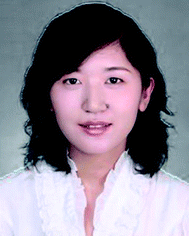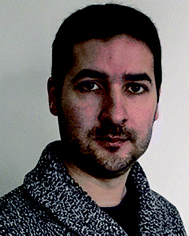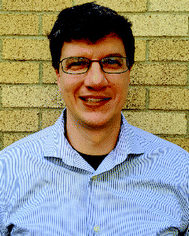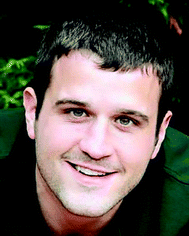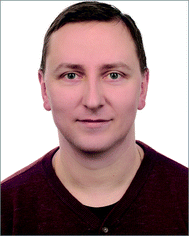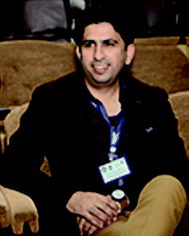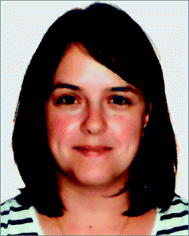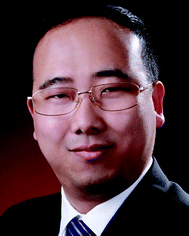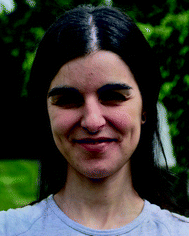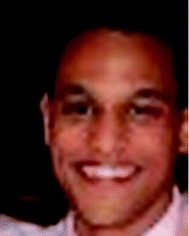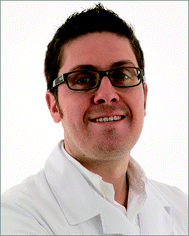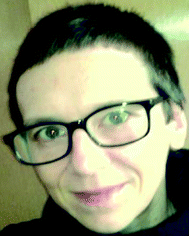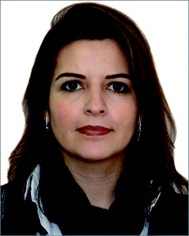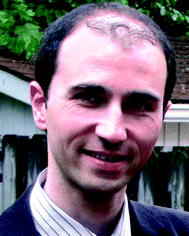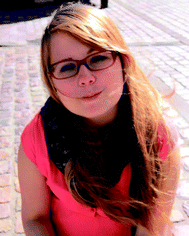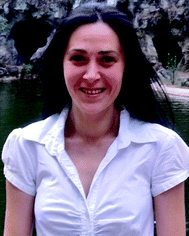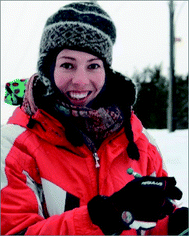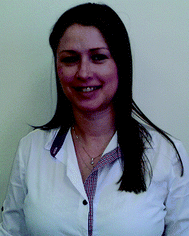Contributors to the Young Analytical Scientists themed issue
C6JA00414H
Beibei Chen is currently an Associate Professor at the College of Chemistry and Molecular Sciences, Wuhan University (China). She received her BSc degree in Chemistry (2005) and her PhD degree in Analytical Chemistry (2010) with Professor Bin Hu from Wuhan University (China). She worked as a Postdoctoral Fellow (2011–2014) at Wuhan University. She is was a Visiting Postdoctoral Fellow with Professors Xing-Fang Li and X. Chris Le at the University of Alberta in Nov. 2013–Nov. 2014. Her research focuses on the development of new hyphenated techniques, involving mass spectrometry and chromatography, for elemental speciation and metallomics.
C7JA00010C
Eduardo Bolea Fernández obtained his degree in Chemistry at the University of Zaragoza (Spain) in 2012. Having obtained a Master degree in Analytical Chemistry from the same university, he is currently a PhD student at the Department of Analytical Chemistry, Ghent University (Belgium) in the “Atomic & Mass Spectrometry – A&MS research group”. His research has been focused on method development for ultra-trace elemental and isotopic analysis using tandem ICP-mass spectrometry (ICP-MS/MS). A second topic of interest is high-precision Hg isotopic analysis using multi-collector ICP-MS. The public defense of his PhD is planned for April 2017.
C7JA00092H
Jonathan Merten received a B.Sc. in Chemistry from the University of Virginia in 1999. He subsequently taught chemistry at Musoma Day Secondary School in Musoma, Tanzania for two years, then worked as a chromatographer at the University of Florida, where he learned to hate sample prep. He eventually joined Nicolo Omenetto, Ben Smith and Jim Winefordner’s lab at the University of Florida, discovering the pleasure of building his own instruments while working in multiple (mostly) laser-related lines of research. While his primary interest is LIBS applications and diagnostics, he benefited from the long history of diverse spectroscopy in the Omenetto–Winefordner–Smith lab, as well as a brief stay in Professor Ulrich Panne’s lab in the Bundesanstalt für Materialforschung und -prüfung in Berlin. His dissertation focused on analytical applications of high repetition-rate, passively Q-switched microchip lasers. Upon graduation, he did a brief postdoc with Susan Allen at Arkansas State University where he learned a great deal more about laser physics from his colleagues at the Arkansas Center for Laser Applications and Sciences. He joined the faculty at Arkansas State University as an assistant professor of Chemistry in 2012. He is currently focused on applications of laser-ablation spectroscopy (including thermal emission, fluorescence and absorption modalities) and implementing classroom strategies to improve undergraduate chemistry students’ metacognition. He is a recipient of the 2014 ORAU Ralph E. Powe Jr. Faculty Enhancement Award and is funded by the Arkansas Biosciences Institute and the US Defense Threat Reduction Agency. He is scheming to return to LIBS plasma diagnostics. Whenever possible, he escapes to the mountains to whitewater kayak and hike. He still dislikes sample prep.
C7JA00102A
Benjamin T. Manard, born in Macon, Georgia, USA, completed his Bachelors of Science degree in Chemistry (2009) at Georgia Southern University while performing research in analytical chemistry under Dr L. Shannon Davis. Benjamin then entered the graduate school at Clemson University and studied analytical chemistry under the direction of Dr R. Kenneth Marcus. He obtained his PhD in 2014 with a dissertation focused on two primary areas: (1) employing capillary channeled polymer (C-CP) fibers as an innovative stationary phase for solid phase extraction of proteins from bio-fluids prior to MALDI-MS detection, and (2) the development of a miniaturized plasma source, the liquid sampling atmospheric pressure glow discharge (LS-APGD), to be employed with OES and MS detection for elemental analysis. During his PhD studies, Benjamin obtained a position as a Visiting Scientist at the Lawrence Berkeley National Laboratory (LBNL) developing laser-based chemical analysis techniques under the guidance of Dr Richard E. Russo. Additionally, Benjamin worked at the Pacific Northwest National Laboratory (PNNL) in collaboration with Dr David W. Koppenaal coupling the LS-APGD as an ionization source on a high resolution Orbitrap mass spectrometer. In 2014, Benjamin was awarded a Glenn T. Seaborg postdoctoral fellow at the Los Alamos National Laboratory (LANL) under the mentorship of Dr Ning Xu. Benjamin’s work was heavily directed towards using plasma-based techniques for trace elemental analysis in special nuclear materials including plutonium and uranium. After completion of his postdoctoral appointment (2016), Benjamin was promoted into a Staff Scientist position at LANL, which he currently holds. He continues his research on plasma-based techniques for trace elemental analyses. Benjamin currently serves on the Executive Committee (EC) of the Society for Applied Spectroscopy and has served on the EC for three years. His hobbies include playing basketball, skiing, camping, and traveling.
C7JA00069C
Dr Ing. Wojciech Jerzy Nowak has been an Assistant Professor at Rzeszow University of Technology since February 2016. He received his BSc degree in Material Science [specialization: Organic Materials Engineering (2007)] at Rzeszow University of Technology, MSc degree in Material Science [specialization: Biomaterials and Composites (2010)] at AGH University of Science and Technology in Cracow and the PhD degree in Material Science [specialization: High Temperature Oxidation (2014)] under the supervision of Prof. Lorenz Singheiser from RWTH Aachen University. During PhD studies he worked as a PhD student in Forschungszentrum Juelich GmbH (2011–2014) in the Institute of Energy and Climate Research (IEK), department: Microstructure and Properties of Materials (IEK-2), Group of High Temperature Corrosion and Corrosion Protection with Prof. W. J. Quadakkers. After his PhD studies he continued working at FZJ as a post-doctoral researcher in the Group of High Temperature Corrosion and Corrosion Protection (2014–2016). Between 2011 and 2016 he participated in two EU-funded projects: “H2-IGCC” (FP7-239349) and “SAMBA” (FP7-309849). He was additionally responsible for performing of all of the analyses using glow discharge optical emission spectroscopy (GD-OES). Since 2016 he has worked at Rzeszow University of Technology in the Faculty of Mechanical Engineering and Aeronautics, Department of Material Science as an assistant professor. Since 2016 he has been responsible for the Section of Chemical Composition Analysis (P2) which is a part of the Research and Development Laboratory for Aerospace Materials at Rzeszow University of Technology, therefore he continuously works with the GD-OES. His research is focused on materials for high temperature application and the processes in the materials during exposure at high temperature.
C6JA00415F
Sohail Mushtaq is currently a Post Doctoral Research Associate in the School of Chemistry at the University of Bristol. He is exploring aspects of the gas phase chemistry that underpin the growth of diamond by microwave plasma enhanced chemical vapour deposition. He earned his M.Sc degree in 2005 and his M.Phil in 2007, both from the Government College University Lahore, Pakistan. After his M.Phil degree he was selected as the Marie Curie Early Stage Researcher at Imperial College (IC) London to work with Prof. J. C. Pickering in the EC Research Training Network on Analytical Glow Discharges (GLADNET). His PhD work was on the effects of traces of molecular gases in analytical glow discharge. For this work, he carried out the first multi-line study for oxygen as an impurity in glow discharges. After his PhD in 2011 at IC he took up a postdoctoral position with Prof. Edward Steers at London Metropolitan University. He has extensive experience of using the Imperial Fourier Transform spectrometer and glow discharge sources, and has carried out experimental work at EAG (Syracuse, USA), EMPA (Thun, Switzerland), BAM (Berlin) and IFW Dresden (Germany). He has made a significant impact in the field with 18 publications; this includes three papers with work featured on the front cover of JAAS and he is internationally known for his work on molecular gases in glow discharges. He was awarded the Payling prize for the best contribution by a young scientist at the 2
nd IGDSS (Internl. GDS Symposium), Prague and also awarded JAAS Emerging Investigator Lectureship 2016. His main research interest is in the fundamental processes in glow discharges and their dependence on the plasma constituent.
C7JA00113D
Vanesa Romero is currently a post-doctoral member in the Environmental Analytical Chemistry and Toxicology research group headed by Prof. Carlos Bendicho in the Department of Analytical and Food Chemistry at the University of Vigo. She received her BS degree in Chemistry from the University of Vigo in 2009 with a special award qualification, and in 2010 she obtained her MS in Advanced Chemistry at the same University. She obtained her PhD, which received the extraordinary doctorate award, from the University of Vigo in 2016. During her doctoral period, she was under supervision of Professor Carlos Bendicho and Isela Lavilla. Her research was focused on the development of solid substrates through the incorporation of nanomaterials for their use as selective sorbents for trace metal analysis and speciation. Her research interests include green analytical chemistry, miniaturization, analytical nanoscience and nanotechnology, and atomic and molecular spectroscopy methods for trace metal analysis. Now she is working as collaborator in a research project focused on the development of new miniaturized methodologies based on the use of fluorescent nanoparticles for the sensing of chemical species.
C7JA00111H
Yong-Liang Yu was born in 1981 in Dandong, China. He received his PhD degree in Analytical Chemistry (2010) from Northeastern University, China, under the supervision of Professor Jian-Hua Wang. His research interest focuses on the miniaturization of atomic spectrometric systems and their applications. In 2008–2009, he worked with Professor Manuel Miro as a visiting student at the University of the Balearic Islands, Spain, by developing analytical schemes for the hyphenation of micro-solid phase extraction to liquid chromatography for automatic multiresidue analysis. In 2010, he joined the Department of Chemistry of Northeastern University as a lecturer, and since then he has devoted his time to the development of novel atomic emission spectrometric approaches based on low-temperature micro-plasma. He is currently a Professor in Analytical Chemistry in the Department of Chemistry of Northeastern University. He has published more than 30 papers in peer-reviewed international journals.
C7JA00090A
María R. Flórez was born in Gijón (Asturias, Spain) in 1984. She studied Chemistry at the University of Oviedo and obtained her MSc diploma from the University of Zaragoza. She defended her PhD in October 2014 within a joint-PhD frame between the University of Zaragoza and Ghent University, under the supervision of Prof. Dr Martín Resano and Prof. Dr Frank Vanhaecke. Since 2015 she has held a post-doctoral position as part of the A&MS research group at Ghent University. Her current research is focused on the development of cell culture models to study biochemical processes leading to isotope fractionation.
C7JA00112F
Dr Yoseif Makonnen obtained his Ph.D. in Chemistry from Queen’s University, where he investigated mixed-gas plasmas and heated-sample introduction systems to enhance the analytical performance of inductively coupled plasma (ICP) spectrometry. He completed a Mitac’s Accelerate post-doctoral fellowship in collaboration with Burgener Research Inc. investigating enhanced sample introduction systems for ICP spectrometry. He is currently working as a post-doctoral fellow, with Dr Diane Beauchemin, in collaboration with Activation Laboratories in Ancaster, Canada. His current research focuses on the development of robust, high-throughput methods for the accurate multi-elemental analysis of geological and environmental samples by ICP mass spectrometry.
C6JA00431H
Hector Gonzalez Iglesias was born in 1979 in Pola de Lena, a small town in the mountains of Asturias, a beautiful region of the north of Spain. As a child he fell in love with “chemistry games”, so followed his passion and studied chemistry at the University of Oviedo. Upon graduation in 2005, he joined the research group of Prof. Alfredo Sanz-Medel and was also mentored by Prof. Marisa Fernández-Sánchez at the University of Oviedo. During the PhD program his research interest was in Bioinorganic Analytical Chemistry where he helped to develop methods for the accurate determination of isotopes in biological samples. He learned to use elemental mass spectrometry techniques, including ICP-MS instruments with different MS detectors such as single quadrupole, octopole reaction system, and sector field, as well as molecular ones including MALDI-MS and LC-MS/MS (ESI and APCI sources). In 2010, he started postdoctoral training at the Institute of Ophthalmology Fernández-Vega – Foundation of Ophthalmological Investigation (IOFV-FIO, Oviedo, Spain), under the supervision of Miguel Coca-Prados (Yale University, USA). He has worked on two main projects: “Genetic and Proteomic Biomarkers in Glaucoma”, and “Biometals in Age Related Macular Degeneration”. His current experience at IOFV-FIO has allowed him to learn many techniques in the field of cellular and molecular biology and the handling of animal models of eye diseases. Currently, he is Principal Investigator of the Unit of Neurodegenerative Eye Diseases at IOFV-FIO. He is a strong believer in the importance of a multidisciplinary approach in science and life.
C7JA00107J
Maja Welna was born in Poland, in 1980. She hopes to become a scientist, an ambition she has held since her early years. From 1999 she has fulfilled her fascination for chemistry at Wroclaw University of Science and Technology (Wroclaw, Poland), Faculty of Chemistry, where she received her MSc in Chemistry (2004) followed by a PhD in Analytical Chemistry (2008). After gaining her PhD she joined the Analytical Chemistry Group and at present works in the Division of Analytical Chemistry and Chemical Metallurgy, doing what she really wants to do. Being associated and inspired by energetic, dynamic and experiencing team she is able to continuously develop herself and her research career. Since 2012 she started her independent research (“habilitation”) focused on the area of analytical atomic spectrometry. Her current interests include: (1) the application of hydride generation techniques for atomic spectrometry (particularly in hyphenation with optical emission spectrometers) to single and simultaneous determinations of hydride-forming elements, (2) improvement in elemental speciation and fractionation without chromatography related to the evaluation of non-chromatographic approaches for species-selective As analysis directly by HG-ICP OES, and (3) the development of methodologies for the determination and non-chromatographic speciation of As using HG-ICP OES in food samples, especially in rice and rice products.
C7JA00139H
Marcia Foster Mesko concluded her PhD in 2008 and she has held a permanent position as Associate Professor at the Federal University of Pelotas, Brazil, since 2009. She has experience in analytical chemistry for the development of methods for sample preparation, atomic spectrometry, food and environmental analysis, speciation analysis and quality control of pharmaceuticals and other industrial products. She has authored more than 10 book chapters in these fields. She supervised eight Masters and one PhD student. She has presented at several conferences in national and international scientific meetings and has received more than 15 national and international awards, including the L’Oreal Brazil – Young Women in Science, Brazilian Academy of Sciences, UNESCO. She has reviewed for more than 15 international scientific journals and has published more 68 peer-reviewed international papers in high-impact journals such as
Journal of Analytical Atomic Spectrometry,
Analytical Chemistry,
Talanta,
Analytical and Bioanalytical Chemistry, among others. She was a staff member of the Brazilian Pharmacopoeia, for 4 years, responsible for the revision of monograph methods for the analysis of pharmaceutical products, and for the development of new methods for quality control of pharmaceutical products. She has worked as an invited researcher at Instituto Nacional de Metrologia, Qualidade e Tecnologia – INMETRO, Brazil (Laboratory of Inorganic Chemistry), for the development of certified reference materials of pharmaceutical products and a method for the direct determination of metals in bioethanol using ICP OES. She has cooperative works with many research groups in Brazil and other countries, such as Austria, Germany and Canada. Recently, she was elected as the vice-director of Analytical Chemistry Division of the Brazilian Chemical Society.
C7JA00115K
Dr Kaveh Jorabchi is currently an assistant professor of chemistry at Georgetown University in Washington, DC, USA. His research interests include the development of new elemental and molecular characterization techniques based on mass and ion mobility spectrometries. Dr Jorabchi’s interest in chemistry formed in high school in Iran under the influence of an excellent chemistry teacher and a group of talented friends. This led him to become one of the four members of the Iranian National Chemistry Olympiad team, winning a silver medal at the 1997 International Chemistry Olympiad in his senior year. He then pursued a BSc in chemistry at Tehran’s Sharif University of Technology and went on to receive a PhD in chemistry in 2006 under the direction of Prof. Akbar Montaser at the George Washington University, focusing on the fundamental investigations and development of plasma ion sources. Dr Jorabchi then completed postdoctoral training with Prof. Lloyd Smith’s group at the University of Wisconsin-Madison, conducting research on molecular ionization. Living in Madison brought him more than science by leading him to his life partner and wife who continually educates him about the arts. Prior to joining Georgetown University, Dr Jorabchi worked as an industrial R&D scientist for 2 years at Syagen Technologies, developing new ion sources for biological and homeland security applications. Dr Jorabchi incorporates elements of his experiences in his research and teaching at Georgetown University. Research in the Jorabchi group spans both elemental and molecular analyses and includes industrial and academic collaborations. His group frequently includes high school students who have received national recognition in science competitions such as Regeneron (former Intel) Science Talent Search.
C7JA00146K
Sofia Gaiaschi is an application scientist working on Glow Discharge Optical Emission Spectrometry at HORIBA Scientific. After a PhD in physics between the École Polytechnique and the University of Paris Sud (France), she spent one year teaching electronics to undergraduate students. Then, she joined HORIBA Scientific to work in the field of instrumentation and applied spectroscopy. When she is not carefully destroying samples using GDOES, you can find her hiking somewhere around the world or trying to speak Japanese with her colleagues.
C7JA00134G
Marta Costas Rodríguez obtained her Ph.D. from the University of Vigo (Spain) in 2011. Her work focused on the development and evaluation of analytical protocols for elemental determinations in biological samples by ICP-MS. Special attention has been paid to the introduction of miniaturized and green sample preparation procedures preceding different techniques. Since 2012, she has been a postdoctoral researcher (currently with a postdoctoral fellowship from the Flemish Research Foundation FWO – Flanders) in the ‘Atomic and Mass Spectrometry’ research group at Ghent University (Belgium). Her research interest is the high-precision isotopic analysis by multi-collector ICP-MS and spatial resolution bio-imaging by laser-ablation (MC)-ICP-MS in a biomedical context.
C7JA00118E
Caroline Welte graduated in Environmental Physics from the University of Heidelberg (Germany) in 2010. During her diploma thesis “
36Cl in rain and cave drip water” she became involved with the use of radionuclides as tracers in environmental processes and paleoclimate research. She started her doctoral studies in a joint project of Analytical Chemistry and Ion Beam Physics at ETH Zurich. During her PhD her research focused on instrumental developments of spatially resolved radiocarbon (
14C) analyses of carbonate records combining Laser Ablation and Accelerator Mass Spectrometry. The main purpose was to optimize the
14C analysis of carbonates and to avoid the labor-intense sample preparation, to be able to acquire spatially resolved
14C measurements even at the μm scale. Under the title “Laser Ablation coupled with Accelerator Mass Spectrometry for online radiocarbon analysis”, she received her doctor of sciences in 2015. She continued her academic career enrolling in a postdoctoral position at the Laboratory of Ion Beam Physics, ETH Zurich (Switzerland) in 2016, and focused on
14C analyses of biomedical samples. This project brought her to her current postdoctoral position in the group of Biogeoscience at ETH Zurich (Switzerland). Her main interests are in the combination of instrumental developments of
14C gas measurements and their applications in order to push the analytical frontiers towards smaller sample sizes and a higher sample throughput.
C7JA00123A
Paola Mello is adjunct professor at the Chemistry Department, Universidade Federal de Santa Maria (UFSM), Brazil. She obtained her PhD in Chemistry in 2011, at UFSM. She has experience in Analytical Chemistry, focusing on the development of analytical methods and process intensification with ultrasound and/or microwaves. Research projects are devoted to the following subjects: sample preparation for elemental analysis, multielemental determination by ICP-based techniques, speciation analysis and coupled techniques (LC-MS, GC-MS, LC-ICP-MS, GC-ICP-MS). She is researcher at the Brazilian National Council for Scientific and Technological Development.
|
| This journal is © The Royal Society of Chemistry 2017 |

